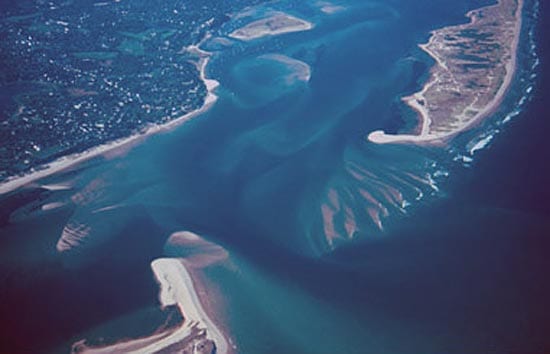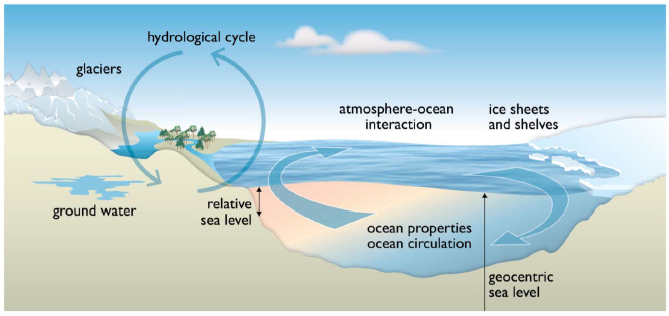Sea-level Changes Along a Coastline May Be Caused by
Shoals and sandbars become islands and then sandbars again. The velocity of the wave slows as it moves into the shore.

Rising Sea Levels And Moving Shorelines Woods Hole Oceanographic Institution
Sea-level changes along a coastline may be caused by.

. There are a few reasons for this such as ice sheets and glaciers melting causing the water to head toward the equator while the sea level near the polar ice caps drops. Changes due to heating of the ocean and changes in ocean circulation Changes in the volume of water in the ocean due to the melting of land ice in glaciers ice caps and ice sheets as. Local sea level is the height of the water measured along the coast relative to a specific point on land.
The coastline near Jean Lafitte National Historical Park and Preserve for example is likely to experience faster rates of relative sea. This is not indicative of sea-level rise but it is estimated that a 13 increase of sea water temperature will cause more frequent occurrence of coral bleaching which will lead to death of the coral reefs. Barrier islands salt marshes tidal marshes most common depositional feature and usually consist of sand elongate sand bars that are attached to.
Along the East Coast of the United States for example three quarters of the coast that is not protected from the ocean by natural or artificial barriers is experiencing erosion because of sea-level rise over the last 100 to 150 years. Eustatic sea-level changes are global sea-level changes related either to changes in the volume of glacial ice on land or to changes in the shape of the sea floor caused by plate tectonic processes. There are three main mechanisms of sea-level change as described below.
The lower parts of the wave shear against the bottom as the water is shallower than the wave base. The freezing and melting of glaciers is not the only cause of sea level change but it is an important one because it is directly related to changing global temperatures. SLR Could Impact Coast Via Flooding Erosion and Rising Groundwater.
To find the source of this threat it is necessary to focus on global warming caused by climate change which causes sea level rise in three different ways. The sea level changes for a variety of reasons. The sea level has and continues to fluctuate greatly throughout time.
Ice sheets grow and shrink causing sea level to fall and rise as water moves from the oceans to the ice caps and back to the oceans. The first is the thermal expansion. During El Niño events as warm water pushes across the ocean heat causes the ocean to expand in turn causing sea level near the Americas to rise with changes of up to 20 cm along the west coast of the US.
Sea level rise will hit the coasts the hardest. Melting or growth of polar ice caps b. Sea level is the average height of the ocean between high and low tide.
The researchers are studying data from satellites and tide gauges to help understand the difference between sea level changes caused by rising global temperatures and those due to naturally occurring cyclic processes particularly the impacts of two natural climate cycles that link conditions in the Pacific Ocean with the atmosphere above. All of these c. Rising Seas Threaten the California Coast in Numerous Ways.
It is important to note that coastal areas will experience sea level change differently owing to the variable nature of ocean currents topography of the coast and the influence of localized changes in land elevation. Tectonic uplift Match up each vocab word with the definition. Second warm water expands and takes up more space than colder water increasing the volume of water in the sea.
Sea level has fluctuated throughout Earths history. The impacts of storms have also increased along the East Coast because of sea. Causes of global changes in sea level are.
The wave height increase as the wavelength decreases. Global sea level is the average height of the ocean around the world. The US East Coast and Gulf of Mexico experienced some of the worlds fastest rates of sea level rise in the twentieth century due to local and regional factors.
First warmer temperatures cause ice on land like glaciers and ice sheets to melt and the meltwater flows into the ocean to increase sea level. Increased coastal flooding from encroaching seas and wavesin the form of both permanent inundation and episodic events caused by stormsis the most commonly referenced SLR risk. A Global Rise or Fall in sea level due to an Increase or Decrease in the Volume of sea water.
There are several terms used to describe sea level. Causes of Sea Level Change. On a day to day basis the sea level changes according to the tide but the sea level also changes on a much grander time scale too.
Hamlington et al 2015. These changes in sea level are normally caused by ice ages or other major global events. Expansion or contraction of seawater in response to the addition or subtraction of heat energy The melting or growth of snow packs and mountain glaciers.
Even the calmest of seas are constantly moving water sand and mud. Eustatic Sea Level Change. The wave becomes too high and steep to support itself.
Melting or growth of polar ice caps. Rates of local sea level dots on the coast can be larger than the global average due to geological processes like ground settling or smaller than the global average due to processes like the centuries-long rebound of land masses from the loss of ice-age glaciers. Sea levels are rising the fastest along the equator.
10Sea-level changes along a coastline may be caused by a. In some ocean basins sea level has risen 6-8 inches 15-20 centimeters. Human activities such as burning coal and oil and cutting down tropical forests have increased atmospheric concentrations of heat-trapping.
For example changes in the rate of mid-ocean spreading will change the shape of the sea floor near the. Mean sea level also known as a tidal datum is the average of the hourly water level heights observed at a local tide station over 19 years. Barrier islands rise from the seafloor are chopped by inlets and retreat toward the mainland.
This is another major concern in terms of the ecological impacts of climate change. Techtonic Movements of the Earths Crust alter the shape of the earths Basins. Global warming is the primary cause of current sea level rise.
The effects of sea-level rise on coastal lands can be destructive. Common causes of relative sea level change include. Water when heated by temperature rise tends to expand ie oceans take up more space.

Sea Level Rise Accelerating Along Us Coastline Scientists Warn Sea Level The Guardian

13 1 Million U S Coastal Residents Could Face Flooding From Rising Sea Levels Study Says Sea Level Sea Level Rise El Nino

Why Does Sea Level Change Sea Level Waves And Coastal Extremes
Sea Level 101 Part Two All Sea Level Is Local Climate Change Vital Signs Of The Planet
Comments
Post a Comment